Kurt Christenson ** Timothy Mucci ** Johnny Gatts ** Brian Bannen ** Rick Lacy ** YOU!
Friday, March 18, 2011
This Space Closed - Moved to Tumblr
Welcome to Write Club. This blog was the home to Write Club in the first two years that we set up the podcast to talk about writing, art, comics and all that jazz.
Now we're transitioning into a new direction and focus, and with that comes a new home. Check out Write Club on Tumblr.
But as long as you're here, why don't you check out our previous podcasts and our articles.
Expect new interviews and podcasts discussing art and writing with a focus on Brooklyn and NYC events over on our Tumblr. And if you'd like to get involved or have something you'd like help promoting please just let us know.
Thanks for checking us out and giving us a listen.
Wednesday, February 2, 2011
"We're Back!" V. 3, Ep. 7
Sunday, January 2, 2011
Comic Reviews -- Week of Dec. 29
Batman: The Dark Knight #1:
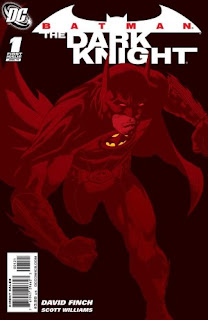
This is Bruce Wayne doing what he does best -- being a detective. Much of this issue seems to be character filler. There's a heart-to-heart with Alfred, Batman kicking the crap out of Killer Croc, and a surprise ending. This seems to be all exposition, leading in to the bigger plot which will be doled out in small pieces. It's not bad, it's not great. It's a strong Batman comic, and it leaves readers curious as to where it's going. I liked a lot of this issue -- particularly Batman's cleverness and resourcefulness. I'd like to see Batman kick more ass in future issues, but I don't think that's something we have to worry about. David Finch has a good handle on how to write Batman, and I'm sure the series will only get better from here.
Misc:
Nemesis #4 (Icon -- Millar & McNiven):
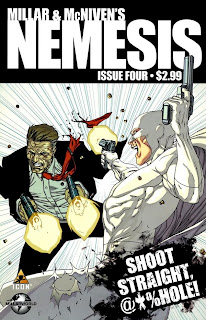
The first page of this issue is possibly the best thing about the entire series. When Blake Morrow reveals whom he believes Nemesis to be, I thought, for a moment, Millar had pulled a fast one over us. But this is Mark Millar writing, and instead we get a deus ex machina moment where Millar somewhat reveals the true identity behind Nemesis. And boy is it stupid. The story makes no sense once you find out who the villain actually is. The simplistic explanation of how a random person could possibly know so much about one man is so contrived that it seemed as if Millar got to this moment in the book, and then ran out of ideas so he had to invent an answer for the problem. What was more saddening was that there's a teaser for Volume 2 of Nemesis. This is a textbook example of "How Not to Write Comics." Pick it up for your reference shelf.
Echoes #1 (Minotaur -- Fialkov & Ekedal):

I wasn't sure what to expect from this. I flipped through it before buying it, so unfortunately I saw the last page before I read the story. Even knowing that, I was gripped by Echoes from beginning to end. Echoes is the story of a man who's father is dying while his wife is close to giving birth. On his deathbed, Brian's father tells him to go back to their old house and look in the basement for a box. When he does this (while he's dealing with psychotic delusions simultaneously), Brian discovers a horrifying secret, and one that I won't ruin here. Rashan Ekedal's art -- just black and white pencils -- work superbly here. I can't imagine the atmosphere being captured as well had this been done in color. There are enough plot elements, and character quirks to keep readers hooked. I have my own thoughts on how the title of the story relates to what will eventually happen, and I'm immediately drawn to Brian as a character, so I hope things work out for him. I'm not holding up much hope of that, however, because Joshua Fialkov has woven such a moody story that I can't see this ending up happily. And I think I'd be okay with that.
Bannen's Book of the Week
Detective Comics #872:

I was about halfway through this book before I remember that Scott Snyder was writing about Dick Grayson and not Bruce Wayne. This isn't a bad thing -- in fact, I think it speaks to the earnestness with which Scott Snyder is writing Detective Comics. He seems to understand the tonal differences between Bruce, Dick, Tim, and even Damien (although he's not present yet -- but I pray Snyder gets the opportunity to write him in). This issue is much like a train going downhill without brakes. Once it gets going, there's an urgency to the writing, and one that really captures the mania of the situation in which Dick finds himself. Jock needs to be commended for his art in this issue, particularly the last three pages where Dick is trapped in an horrific auction run by a psychotic auctioneer. Snyder must feel like the proverbial kid in the candy store, handed the keys to one of the greatest kingdoms in the DC Universe. So far, he's doing a great job. He's playing it cool now, developing character and story rather than going full on with the toys he's just inherited. I spoke highly of Snyder's American Vampire series, but seeing as that was an original idea, I didn't know what to expect. So far, I'm beyond impressed. This is a great series, utilizing the cornerstones laid by Grant Morrison. The story moves along quickly, gives us some nice character moments (particularly between Dick and Barbara), and ends with a great cliff-hanger. If you're looking for a time to get into Batman, it is now.
Monday, December 6, 2010
Rick Lacy: Back to School!
Monday, November 29, 2010
KGB Bar - Live Comics Reading
I knew Emily Wernet had done a turn back around when I reviewed her comic 'Moonlighting', but other than that I hadn't heard of it or where I could get info. Afterwards I stumbled across Tom Hart's blog, the organizer and teacher of cartooning, which provided me with the names of the night's artists and their spots on the web.
Just as an aside, I have one of Tom Hart's 'Hutch Owen' books and I really dug it, one of my first indie cartoonist books I ever bought.
So I stumbled in with my girlfriend Laura Lee (on our third anniversary, and yes, that's months thank you), grabbed a Baltika, a huge Russian beer that is, and we tried not to stand in the way. I had no idea who was going to come out, but I recognized Alex Robinson in the corner, so I knew this would be good.
(I love Box Office Poison and have a sketch inside my copy, hell yeah.)
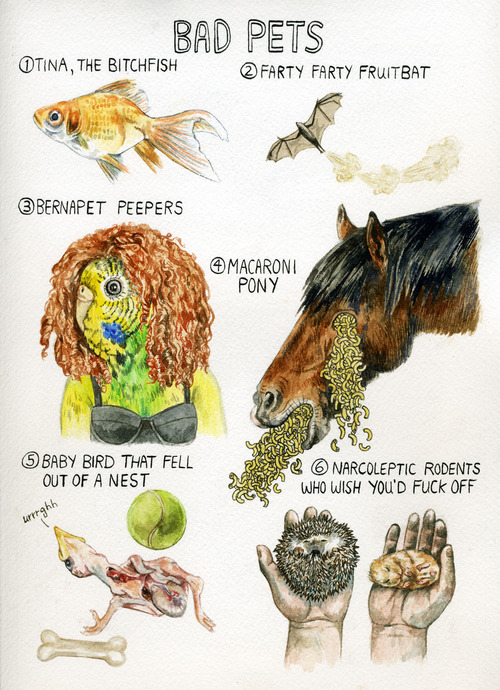
First up came Lisa Hanawalt, who you can meet tonight at Desert Island Comics in Williamsburg as she signs at her launch party for I Want You #2 and her window display at Desert Island.
She warmed up the crowd with her twisted lists from Bad Pets, to Awesome Hats, and How To Tell Martha Stewart's Drunk. Her art style is a wonderfully chaotic balance of fine line illustration and madcap absurdity, bordering on the grotesque at times, though always able to provoke, often into laughter.
Next up was Mike Dawson who was sitting over by Alex Robinson, and I guess that makes sense as they have very similar sensibilities.

He read a selection from his comic Troop 142 which is about as accurate a portrayal of young male life in America as I've seen. It's juvenile and possibly even nonsensical, but absolutely genuine and pure in its delivery of innocence as it lingers for those last few years before being a teenager truly kicks in.
Then there was a brief intermission so we could grab more beers. After we were settled in, then came the closer...Kate Beaton ladies and gentlemen!
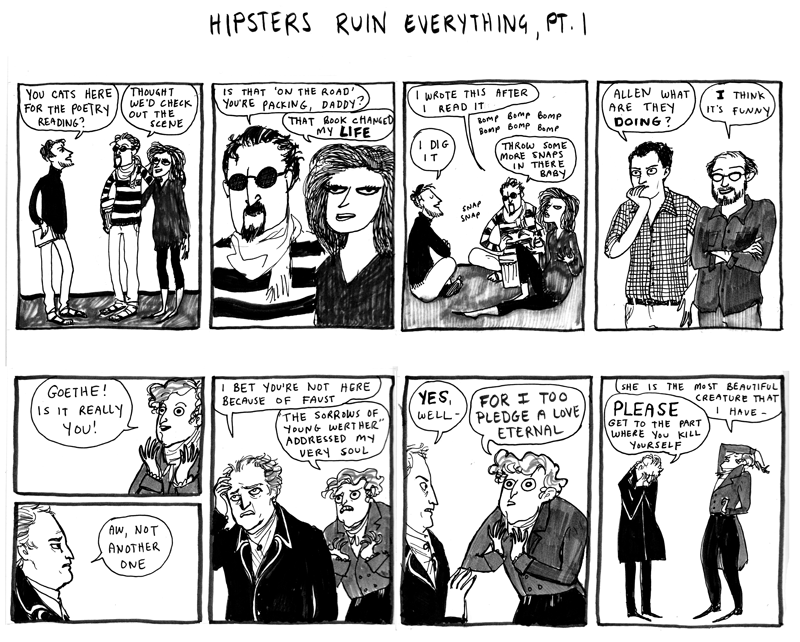
I mean, if there's a cartoonist out there that has more buzz on them besides Kate Beaton, well then point them out dammit! From her Aquaman which has made the rounds on Tumblr, the Gatsby's, the Mystery Solving Teens...I mean, just go to her site and prepare to lose at least an hour as you take it all in. It's consistently funny, in the art style, and delivery of every punchline. You know what's even better than that though? Having Kate herself deliver the lines. Her voice, perfectly gravelly and deadpan as she hits every beat, knowing her strips through and through.
This was definitely a great event that I'd like to see more often than just every three months. Let me see what I can do, maybe wrestle up a venue, certainly know enough artists that'll show their work. Hmmmm...
In the meantime, check out these artists, as all are very top notch indie creators, and come swing by Desert Island tonight and say hello.
K
Lisa Hanawalt
Mike Dawson
Kate Beaton
Thursday, November 11, 2010
CASANOVA Review
CASANOVA
by Matt Fraction and Gabriel Ba
What the FUCK did I just read? It's like old Marvel 'Nick Fury, Agent of SHIELD' comics thrown in a blender with Grant Morrison's 'Invisibles' then trying to repaint Michael Moorcock's Jerry Cornelius books. Granted it's all done with Matt Fraction's indelible wit and chock full of chunky ideas and action packed segments.
It's an attractive hardcover, with a 60's-70's vibe plastered all over it, from the trippy color palate and stark design, to the moody Paul Pope/Nick Cave-ish face of Casanova himself. It's quite unlike any other book out there in packaging, if not concept, but it comes with a hefty price tag of $24.99. Is it worth that?
Not really. The gags and action are quite awesome, and the general concept of a time swapped thief turned superspy caught between various warring factions, well that's just all kinds of awesome, tossing in all the things I love. But it really tries to be too clever. The plot is all over the place and I find myself trying to work out what happened and it really is nearly incomprehensible.

And I'm a well trained comic book reader here folks, with twenty years of experience, so I know what I'm talking about. The story has its moments, and the clever ideas are indeed quite clever, and mostly well executed, but the rest inbetween, that little thing we call the plot, it's about as flimsy as it comes.
It reminds me a lot of Fraction's earliest comic, 'Rex Mantooth' from Planet Lar/AIT, which featured a giant talking gorilla supersecretagent in a tuxedo that was illustrated by the lovely Andy Kuhn, and was also chock full of fun (especially the annotated Mantooth which has a running commentary beside each page). But where that was goofy and played it, I feel like Casanova wanted to be taken a bit more seriously, and it falls short.
Granted it does play with the spy tropes and throws in a lot of comic book idioms, but really it's just a big mess of a story with tasty bits. Now, the artwork is quite stunning, and even though the single color shading throughout took some getting used to, it was cool to see something new and when it worked, it worked well. I never was lost to what was happening visually. Just I didn't quite follow the leaps in logic and story structure.
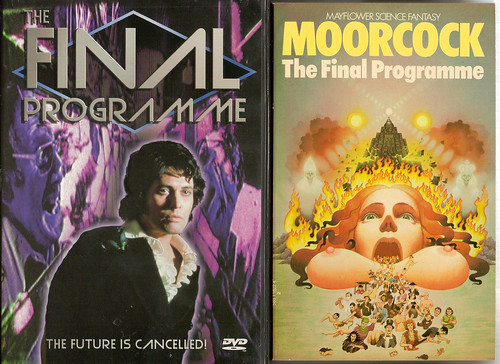
Now, similar critiques could be made about Moorcock's Jerry Cornelius stories, which I love more in theory than practice, but at least he was out there doing it first. Instead this story feels like a cross between a failed pulp novel and an old SHIELD pitch for Marvel with a few hip ideas swiped from today's more polished and esoteric writers.
This isn't a Fraction bash-fest mind you. When the man is on, he's on. His work on Iron Man started rough but rose to brilliant levels, and the previously mentioned 'Rex Mantooth' was thoroughly enjoyable. Maybe I just had high expectations from the concept for the story (sexy superspy sci-fi pulp) and the reviews of it from friends who've read it.
All in all, it wasn't NOT worth reading, and it does set things up in the end (the rather blunt and abrupt ending that wraps up NOTHING) that could potentially make for a really cool second attempt at telling this type of story, but this arc I would consider a failure, and as all spies know, failure will not be tolerated.
I give you all license to kill this book from your reading list.
K
Thursday, November 4, 2010
Warren Ellis' "On What Comics Can Do"
For the last three months or so, I've been working piecemeal in spare time on a short booklet about writing comics. Here's one small piece of it, the beginning of a section:
In what ways are comics not like film, you ask (in my head)?
Illustration creates a suspension of disbelief.
If Art Spiegelman’s MAUS had been filmed first, it would have had an audience of maybe three people at Sundance. Because the moment everyone trooped on wearing their mouse masks, any larger audience would have lost it and left giggling. Only in the space of cartooning could that conceit work. Not least because we’re already aware, when we come to cartooning, that we’re looking at someone’s processed and hermetic perception of the world. The great success of MAUS is that the mouse faces make us let our guard down, and so we’re hit by the horrible truth of that book from an unprotected angle.
There’s a page I often cite in these conversations, from the 1974 comic MANHUNTER by Archie Goodwin and Walt Simonson. It’s an entire Jason Bourne sequence in a single page. In a Marrakesh alleyway, Damon Nostrand is in a car attempting to run down Paul Kirk and Christine StClair. Kirk pushes StClair to cover, rolls under the speeding car, draws a knife, tears it through the car’s petrol tank as it passes over him, gets clear, lights a match, touches it to the trail of petrol the car leaves, the petrol blazes down the alley to the car, the car explodes, and then they do three or four lines of dialogue while watching Nostrand burn to death about how it’s horrible but really he was a bit of a git and completely deserved it. One page. Employing “camera angles” and compositions that even now the likes of Paul Greengrass would go blind trying to replicate.
Also: a curling, snarling Peter Kuper piece can sear the page with its anger in a way that no photorealistic artist will ever be able to communicate. A room drawn by Eddie Campbell will be more real than any snapshot, because his line is almost like handwriting, and has human breath upon it. Dash Shaw’s work may look rough on first look, but stay with it, look at how he conveys the essence of an idea in every panel, and you’ll realise how hard he sometimes works to evoke an entire world with so few elements.
All of which is to say you’re not necessarily hemmed in by realism, or naturalism of any kind. This is a field that combines, on the one hand, the novel and the poem and the slogan and the news story, and on the other hand every stop from pointillism to cave painting. Understand comics as the marriage of word and picture, as simple as that, and you’ll get a sense of how broad the medium’s reach really is.
I’m currently driving my FREAKANGELS artist Paul Duffield mad by making him draw a sequence partly inspired by the main titles of Gaspar Noe’s ENTER THE VOID. Which is all typography and signwork.
Comics are not film. Film can do some things we can’t. But we have a far larger toolbox.

 Point yer podcatcher here!
Point yer podcatcher here!